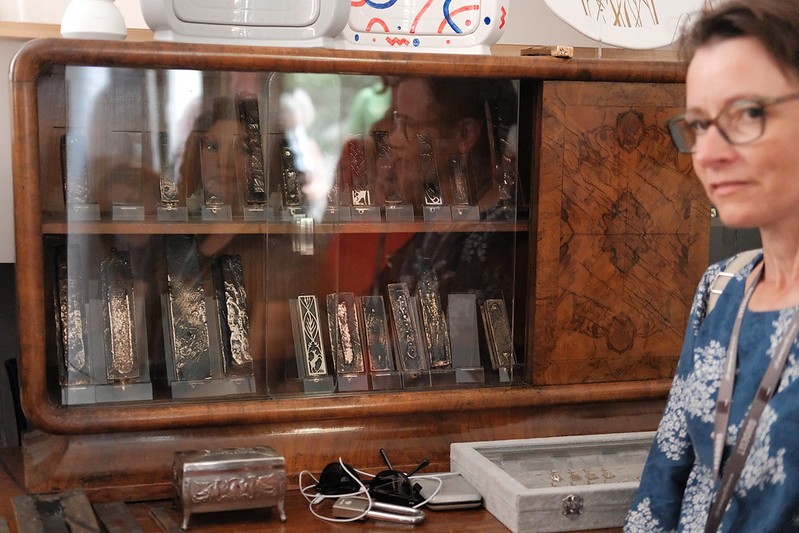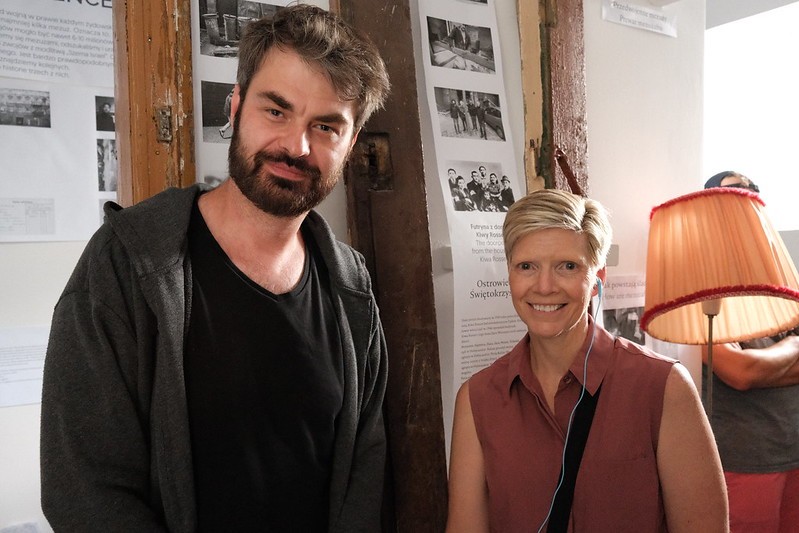WARSAW, Poland — Kristin Thompson wasn’t expecting to encounter the story of her close friend, Holocaust survivor Aaron Elster, mere hours after landing in Warsaw on Tuesday.
But late afternoon, during a tour of the Warsaw Ghetto, Thompson and the jetlagged group she is helping to lead — 16 K-12 teachers from Minnesota and other parts of the country, two other trip leaders, two daughters of trip leaders, one tour guide, and one TC Jewfolk associate editor — shuffled through a residential alleyway to enter a small basement apartment.
Inside was a makeshift headquarters for Mi Polin, a Polish Judaica producer with a unique centerpiece project: Finding old doorposts with the telltale indents of having once held mezuzot (Jewish ritual scroll holders), and making bronze casts of those indents for new mezuzot.

A display of Mi Polin’s mezuzot, made from casts of mezuzah indents in doorposts from pre-WWII Jewish homes (Lev Gringauz/TC Jewfolk)
“So far we were able to find 117 mezuzah traces across Poland, Belarus, Ukraine, Hungary and Romania,” said Aleksander Prugar, a co-founder of Mi Polin. “The traces are very, very rare,” and are becoming even harder to find as people renovate homes built before World War II and dispose of old door frames.
But sometimes, miracles happen — as they did with this meeting with Prugar and the Jewish Community Relations Council of Minnesota and the Dakotas’ second-ever Power of Place trip, in which the JCRC brings teachers to Europe for hands-on Holocaust education. The trip is a joint venture with Humanus Network, Thompson’s Holocaust education consulting organization.
One of the doorposts Prugar happened to have on display was from the childhood home of Aaron Elster, a Polish Jew who was hidden in an attic with his older sister to survive the Holocaust. Elster, who later became a prominent member of the Illinois Jewish community, wrote a book about his experience and publicly shared his Holocaust story — including, for many years, to Kristin Thompson’s classes.
The first time Thompson, then a K-12 teacher in Minnesota, called Elster to invite him to visit, Elster made his boundaries clear: “I’ll let you get by this time, but Sunday night is my poker night — you can’t ever call me again on Sunday night,” Thompson recalled Elster saying. As for the visit to her classroom, of course he would come. And so Elster visited for nearly a decade.
The two became close friends, and remained so as Thompson went from Minnesota teacher to educational program coordinator at the U.S. Holocaust Memorial Museum in Washington, D.C.
“He sent my daughter a graduation card…my husband would go pick him up at the airport, and then we’d go out for dinner,” Thompson said.
Elster’s doorpost, meanwhile, stayed in its place in the Polish town of Sokolow-Podlaski for decades until the current owners underwent a property renovation and replaced it. The municipality took the doorpost away for garbage disposal, and after receiving a tip, Prugar rescued it from a dumpster.
Later, Prugar identified the doorpost as belonging to the butcher shop that Elster’s parents owned before the Holocaust, and he cast the mezuzah imprint to create new bronze mezuzot from it. Now an exhibit item, the doorpost was scheduled to be sent to Vienna the very next day to be displayed in a museum. Had the group come at any other time, Thompson would have missed the doorpost — having been none the wiser.
Elster died in 2018, on Yom Hashoah, the Israeli Holocaust Remembrance Day, and Thompson is still deeply connected to Elster, especially now that she works as an independent consultant on Holocaust education. “Of all the people,” she said, trailing off from surprise and emotion at this one-in-a-million encounter with Elster’s story.

Thompson and Prugar stand together, with Aaron Elster’s doorpost between them (Lev Gringauz/TC Jewfolk)
Of course, she’ll order a mezuzah imprint from the doorpost. For Prugar, it feels like a true fulfillment of Mi Polin’s mission in saving the mezuzah traces.
“Our position is very unique because we are in the middle — behind the past and the present,” Prugar said. “When we do our mezuzah trace discovery, our work isn’t finished. Because the second step is to create a documentation to reveal the family fate of those who lived with the mezuzah traces on their doors.”
Doing so brings the stories of these individual families to a new audience, making sure they are not forgotten.
“Bring back to life, this is our aim,” Prugar said. “To bring back the remembrance.”




















Great story, well told!